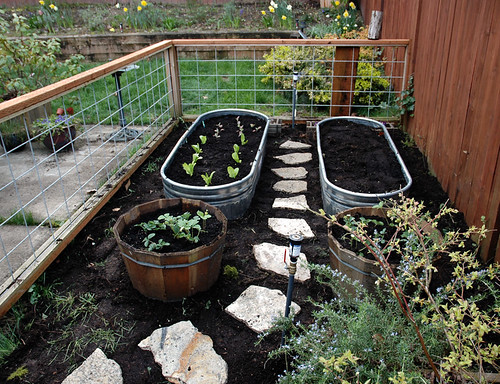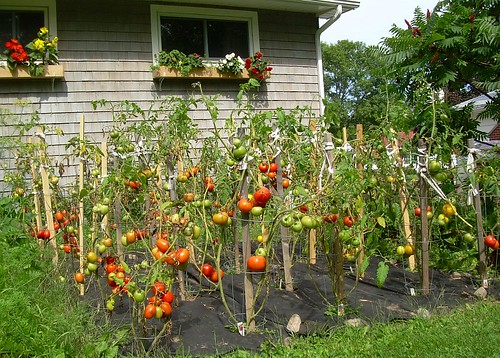
TheGardenLady received this question from Tricia.
I am very new to gardening, but would love to grow my own veggies. I have a starter set with lettuce, tomatoes, and peppers. I have a large space in my backyard, but it is full of wood chips. Can I plant here? If so what is my next step. Do I need a fence so animals do not get to it?
To have success with vegetable gardening, because vegetables love good friable soil with excellent drainage, you will have to do a lot to prepare your large space. Space alone is not enough to have a vegetable garden. The space for vegetable gardening must be in the sun. Vegetables, especially tomatoes, need all the sun they can get.

Without the proper preparation, you are setting yourself up for frustration and perhaps failure. So this year, you might consider planting vegetables in pots while you get the space in your backyard ready for planting. Buy good potting soil that says it is for vegetables. Some of these soils have fertilizers added to help the plants. Buy or get large pots and plant your vegetables in them this year. You can use either clay pots or plastic pots so long as there is a drainage hole in the bottom of the pot. Then you can start doing the hard work for next year’s vegetable garden in your allotted space.
The first thing to do is to get rid of wood chips where you want to plant vegetables. Wood chips take a long time to decompose but offer little nutrition to the soil.
When you have gotten rid of the chips, you will have to prepare the soil. Ideally this should be done in the fall when it is dry. If the soil is too wet, it can become compacted.You should put a fence around the area where you want to grow the vegetables to keep animals like rabbits or neighbors pets out of the garden. Did you know that dogs like to eat tomatoes? Cats may want to dig in the soil to use it as their potty. If you have deer in your area, the fence has to be 8 feet high. You need a lower fence to keep rabbits out- if you put up a wire fence be sure the holes in it are small enough to keep baby rabbits out. And if you have woodchucks, you should bury fencing into the ground. Here are directions.
1. Erect a “rat wall” fence around gardens and fields. Make sure the woodchucks can’t climb over or dig under this barrier. Use 1-1 1/2″ chicken wire. The fence must be 4 feet high and buried 1 foot deep; if you prefer, you can bury it only 1-2″ down, if you bend the edge outward into a “L” shape that sticks out at a 90° angle to prevent the woodchucks from burrowing underneath it. Also bend the top 15″ of the fence out at a 45° angle to keep them from climbing over it, or add an electric wire strung 4-5″ above ground level, and 4-5″ from the outside of the fence.
2. Another modification of the rat wall design. Use 2 × 4″ welded wire that’s 2 ft. high, bottom buried in the L-shaped shelf as described above. String an electric wire across the top of the fence. (Durable and effective but more expensive.)
Now you will want to start the soil preparation. See here.  You will want to till the soil 8 inches deep and add organic material like animal manure or compost to the soil. Use only animal manure from animals that do not eat meat- like horse, cow or chicken manure. Do not use manure from cats or dogs because they are meat eaters.
Most vegetables like a slightly acidic soil pH within the range of 6.0-7.0. To learn what the ph of your soil is or to learn what you might need to add to make the soil best for your vegetable garden, you should have the soil tested. The best soil kits, TheGardenLady thinks, are sold by your local extension office or Master Gardener office. Check the map for the office nearest you. The results will tell you how to proceed and the Master Gardeners will help you when the results are in. They will also answer, for free, all your gardening, insect and diseases of plants problems you have.
After you have the results of the soil test, you can add fertilizer if needed.
Now you may say that you want your garden THIS year. Consider making a garden of raised beds. You can make a raised bed garden this season once you have removed your woodchips because you will be adding fresh soil to the beds. You will have to remove all the grass and weeds and then dig the soil to a depth of 12 inches. That depth ensures good drainage which is something vegetables must have. You will have to build boxes without a top or bottom with sides about 12 inches high- you can make these boxes out of numerous materials like wood or cement blocks, etc. Friends who make these boxes do not make them too wide so that they can reach easily to the center to reach all the plants. Otherwise you should make a path in the box so that you can get to the inside plants. Fill the boxes with good top soil and fertilizer and plant the vegetables in these raised bed boxes. If you have animals, you should add fencing. You can cover the sides and even the tops of the boxes with plastic fencing- either removable fencing or permanent fencing. If you make permanent fencing, it can be used if you plant climbing veggies. Just be sure to plan for a way of opening permanent fencing. For details on building raised beds check out this site.
Hope this has helped. Let TheGardenLady hear about your vegetable garden. Photos would be nice.
